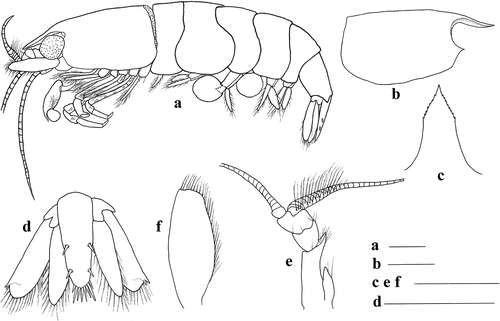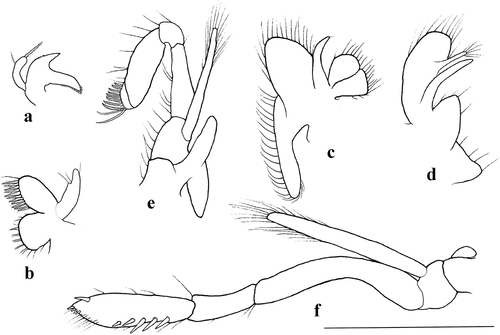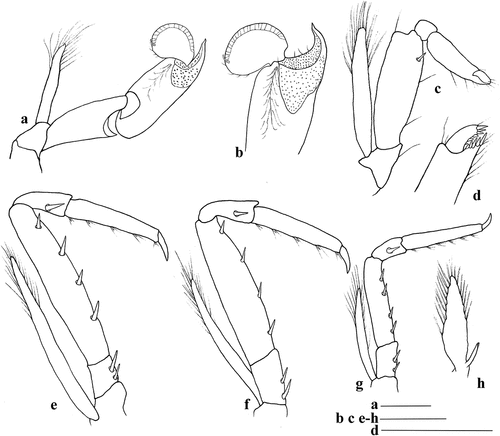Abstract
A new species of Disciadidae Rathbun, 1902, representing the first recorded observation of this caridean family from the South China Sea, is here described and illustrated from nearshore waters off Jinqing Island, in the Xisha Islands. The new species, Discias nanhaiensis sp. nov., is likely associated with a calcareous sponge species, Leucaltis sp. It is characterized by a lanceolate rostrum with serrated margins, a dorsomedial posterior tooth on the second pleomere, an unarticulated mandibular palp, non-serrate lateral margin of the uropodal exopod, and distal margin of telson with four pairs of spines, and these combined features may distinguish the new species from its congeners. An identification key to all Discias species is provided.
http://urn:lsid:zoobank.org:pub:0645B1F0-C9E4-4F30-8593-2C062CBC988B
Introduction
Disciadidae Rathbun, Citation1902 is a rare caridean family characterized by species with tiny body size, well-developed exopods present on all pereopods, and a disc-like dactylus of the first pereopod (Rathbun Citation1902; Vereshchaka Citation1997; De Grave & Moosa Citation2004). At present, four genera (i.e. Discias Rathbun, Citation1902, Kirnasia Burukovsky, Citation1988, Lucaya Chace, Citation1939 and Tridiscias Kensley, Citation1983) are recognized within the Disciadidae; among these, Kirnasia (northeast Atlantic), Lucaya (Bahamas and Gulf of Mexico) and Tridiscias (Transkei, South Africa) are only reported from their type locality and adjacent waters (Chace Citation1939; Kensley Citation1983; Burukovsky Citation1988). Only the genus Discias, also the most species-rich group in the Disciadidae, is recorded from temperate to tropical waters worldwide.
Currently, there are eight valid species of Discias known from the Pacific, Atlantic and Indian Oceans (Bruce Citation1976; Kensley Citation1983; Boothe & Heard Citation1987; Fransen Citation1987; Myers & De Grave Citation2000; De Grave & Fransen Citation2011; Pachelle & De Grave Citation2015). However, only two species have been recorded from the northwest Pacific Ocean, namely Discias exul Kemp, 1920, recorded from the Ryukyu Islands (Nomura et al. Citation1996; Komai & Segonzac Citation2003; Pachelle & De Grave Citation2015), and Discias musicus Holthuis, Citation1981, originally described from the Mariana Islands (Holthuis Citation1981). During an ongoing study of caridean shrimps collected by the Marine Biological Museum, Chinese Academy of Sciences, one disciadid specimen collected from the Xisha Islands could not be identified. Detailed examination and comparison with known species indicate that it belongs to a new species, and represents the first recorded observation of the family Disciadidae from the South China Sea. This new species is described and illustrated herein as Discias nanhaiensis sp. nov.
Material and methods
The specimen was collected from Jinqing Island, Xisha Islands, in the South China Sea in 1958; it is now preserved in 75% ethanol and deposited in the Marine Biological Museum, Chinese Academy of Sciences, Qingdao, China. Morphological details were examined and illustrated with a stereomicroscope (Nikon SMZ1500, Japan). The following abbreviations are used: CL, carapace length, the length from the posterior orbital margin to the posterior margin of carapace; Coll., collector(s); MBM, the Marine Biological Museum; No., collection number; mm, millimeters.
Taxonomy
Family Disciadidae Rathbun, Citation1902
Genus Discias Rathbun, Citation1902
Species Discias nanhaiensis sp. nov.
urn:lsid:zoobank.org:act:536A5ACC-7A3A-47B6-B123-8B949263FE17
()
Figure 1. Discias nanhaiensis sp. nov., holotype. (a) habitus, lateral view; (b) carapace, lateral view; (c) rostrum, dorsal view; (d) telson and uropods, dorsal view; (e) right antennule, dorsal view; (f) left scaphocerite, dorsal view. Scale bars: 1.0 mm.

Figure 2. Discias nanhaiensis sp. nov., holotype. (a) right mandible, outer view; (b) left maxillule, outer view; (c) left maxilla, outer view; (d) left first maxilliped, outer view; (e) left second maxilliped, outer view; (f) left third maxilliped, lateral view. Scale bar: 1.0 mm.

Figure 3. Discias nanhaiensis sp. nov., holotype. (a) left first pereiopod, lateral view; (b) chelae of left first pereiopod, lateral view; (c) left second pereiopod, lateral view; (d) chelae of left second pereiopod, lateral view; (e) left third pereiopod, lateral view; (f) right fourth pereiopod, lateral view; (g) left fifth pereiopod, lateral view; (h) endopod of left second pleopod, lateral view. Scale bars: 0.5 mm.

Type material
Holotype
MBM136611, ovigerous female, 2.6 mm CL, Jinqing island, Xisha Islands, South China Sea, depth 3–10 m, Coll. Fan & Xu, No. 58c-6066, 1 May 1958.
Description
Carapace glabrous; orbit rounded; suborbital angle not delimited; robust antennal spine marginal, acute; branchiostegal spine absent; pterygostomial margin rounded ()). Rostrum reaching to distal end of second segment of antennular peduncle, descending, slightly curved distally, dorsoventrally compressed, lanceolate, apically acute, distolateral margins serrated with seven minute teeth on left and eight minute teeth on right ()).
Pleura of all pleonal somites with rounded margins in both anterior and posterior corners; second pleonal somite with strong middorsal spine on posterior margin. Sixth pleonal somite about 1.2 times as long as fifth in middorsal length, 1.6 times longer than wide ()). Telson slightly longer than sixth pleonal somite, tapering posteriorly, lateral margins straight, entire, not serrated; posterior margin rounded, armed with four pairs of spiniform setae, outermost pair shortest, sub-outer pair longest; dorsolateral surface with two pairs of robust spines, proximal pair situated at 0.55 of telson length, distal pair at 0.81 of telson length ()).
Eye well developed; cornea semispherical, longer and broader than proximally tapering stalk ()).
Antennular peduncle not reaching end of scaphocerite; proximal segment about 3.0 times longer than intermediate segment, with well-developed stylocerite reaching midlength of proximal segment (including distolateral angle), distolateral angle strongly produced. Intermediate segment subequal in length to distal segment, widened distally, cup-like in shape, distal margin with several delicate setae. Distal segment slightly wider than long. Upper flagellum with swollen proximal section of about 11 articles bearing clusters of aesthetascs ()).
Scaphocerite 2.6 times longer than wide, widest at midlength, lateral margins convex; distal margin truncated, distolateral tooth absent ()). Antennal peduncle nearly reaching middle of scaphocerite, without spine on segments.
Mandible with oblong unarticulated palp, bearing one long, sturdy apical seta and one thin subapical seta; incisor process slightly shorter than palp, triangular, margins serrated, apex acute; molar process long, curved downward, distal part and lower margin serrated with acute teeth ()). Maxillule with palp broad, with a minute, seta-bearing projection arising at distal one third of inner margin; outer margin of distal endite armed with dozens of spiniform setae, outer margin of proximal endite furnished with long setae ()). Maxilla with long curved palp; scaphognathite long, lateral border with distinct notch, upper part broader than lower part; distal endite bilobed, outer margins furnished with long setae ()). First maxilliped with feebly developed exopod bearing six distal setae; caridean lobe broad, prominent; palp long, nonsetose, about 2.0 times as long as exopod ()). Second maxilliped with well-developed exopod, reaching to middle of carpus; endopod with semicircular dactylus, terminal margin armed with 10 spiniform setae; propodus long, broad; carpus short, curved; meral segment and ischial segment fused, slightly longer than propodus ()). Third maxilliped with exopod nearly reaching to end of antepenultimate segment of endopod; ultimate segment 1.9 times as long as penultimate segment, widest at about distal one third of its length, then tapering to apex, distomesial margin armed with four spinules, one strong spine and row of setae, proximomesial margin armed with five strong spines; antepenultimate segment slightly shorter than distal two segments combined, distinctly curved at middle ()).
All pereiopods with well-developed exopods. First pereiopod robust, reaching to distal one fourth of scaphocerite when extended forward. Dactylus subcircular, with hyaline cutting edge and a long spiniform seta near terminal margin. Propodus robust, palm about 2.4 times longer than wide; fixed finger strongly arched, terminating in slightly recurved acute apex; occlusal surface bi-carinate, somewhat excavated to accommodate occlusal margin of dactylus. Carpus very short, compressed, inlaid in proximal one third of propodus. Merus and ischium fused, their combined length shorter than propodus, flexor-distal part excavated to accommodate carpus when flexed. Exopod slightly overreaching distal end of ischio-merus segment, distal one third with long setae ()).
Second pereiopod smaller than first pereiopod, nearly extending to mid-length of scaphocerite, chelae well developed. Dactylus about one third length of propodus, cutting edge with six stout spines increasing in size distally. Fixed finger shorter than dactylus, cutting edge with five stout spines increasing in size distally. Propodus about 2.4 times longer than wide (excluding fixed finger). Carpus short, about as wide as long. Ischio-merus segment robust, longer than combined length of dactylus, propodus and carpus, lateral surface with one subdistal movable spine adjacent to ventral margin. Exopod extending to distal end of ischium-merus segment, distal one third with long setae ()).
Third to fifth pereopods generally similar in structure, but decreasing in size posteriorly ()). Third pereiopod reaching to distal one fourth of scaphocerite when extended forward; dactylus about 0.26 times as long as propodus, slender, simple; propodus 5.0 times longer than wide, feebly tapering distally, ventral margin with five minute spiniform setae flanked by two long basal setae; carpus about half length of propodus, outer surface with strong movable spine; merus subequal in length to distal three segments combined, ventral margin armed with four evenly spaced movable spines; ischium short, about one fifth length of merus, outer surface with two movable spines. Exopod long, extending to four fifths length of merus, distal one third with long setae ()). Fourth and fifth pereiopods with carpus armed with one movable spine, merus armed with four movable spines, ischium armed with two movable spines ()). Dactylus of fifth pereopod twisted at base ()).
Pleopods typical for genus, endopod of second pleopod with slender appendix interna basally ()). Uropods slightly longer than telson, exopods with lateral margin straight, entire, terminating in an acute tooth, an articulated spine internal to terminal tooth; endopods narrower than and as long as exopods ()).
Eggs large, diameter about 0.6 mm.
Male
Unknown.
Color in life
Unknown.
Habitat
The original collection records do not indicate the habitat of the new species, but the specimen was preserved together with an adlittoral sponge, Leucaltis sp., in the same jar as the specimen. It is therefore speculated that the new species is associated with these sponges, and an association with sponges has been demonstrated or inferred for most of Discias species (Bruce Citation1976; Kensley Citation1983; Pachelle & De Grave Citation2015).
Etymology
“Nanhai” means the South China Sea in Chinese; the new species is named after its type locality.
Remarks
The new species appears to be morphologically close to Discias exul Kemp, 1920, D. serratirostris Lebour, 1949, D. brownae Kensley, Citation1983 and D. pascuensis Fransen, Citation1987. They all have an acute rostrum with serrated margins, a middorsal spine on the posterior margin of the second pleomere, and the lateral margin of the uropodal exopod unarmed. However, D. nanhaiensis sp. nov. can be distinguished from D. exul and D. brownae by its unarticulated mandibular palp (vs. biarticulated). Discias nanhaensis sp. nov. differs from D. brownae, D. serratirostris and D. pascuensis by its telsonic apex with four pairs of spines (vs. three pairs). Furthermore, the new species D. nanhaiensis sp. nov. is separated from D. exul and D. serratirostris by having four meral spines on the fifth pereiopod (vs. two and three, respectively), and is distinguished from D. pascuensis by the unarmed lateral margins of the outer uropodal exopod. An identification key modified from Kensley (Citation1983) is provided below.
1. Outer uropodal exopod with lateral margin serrated. 2
Outer uropodal exopod with lateral margin entire.3
2. Posterior margin of second pleomere with middorsal spine. D. serrifer
Middorsal spine absent from second pleomere. D. vernbergi
3. Mandibular palp absent .D. musicus
Mandibular palp present. 4
4. Lateral rostral margins entire; rostrum apically rounded. D. atlanticus
Lateral rostral margins serrated; rostrum apically acute.5
5. Mandibular palp uniarticulated. 6
Mandibular palp biarticulated .8
6. Telsonic apex with four pairs of spines.D. nanhaiensis sp. nov.
Telsonic apex with three pairs of spines.7
7. Fifth pereiopod with two meral spines.D. serratirostris
Fifth pereiopod with four meral spines.D. pascuensis
8. Telsonic apex with four pairs of spines.D. exul
Telsonic apex with three pairs of spines.D. brownae
Key to species of the genus Discias Rathbun, Citation1902
Acknowledgements
The authors are grateful to all the managers of the MBMCAS for their assistance with specimen collection. We sincerely thank Dr. Lin Gong (Institute of Oceanology, Chinese Academy of Sciences), who identified the associated sponge. We also appreciate the anonymous reviewers for their valuable comments and suggestions that have helped improve this paper substantially.
Disclosure statement
No potential conflict of interest was reported by the authors.
Additional information
Funding
References
- Boothe BB, Heard RW. 1987. Discias vernbergi, new species, a caridean shrimp (Crustacea: Decapoda: Bresiliidae) from the northwestern Atlantic. Proceedings of the Biological Society of Washington 100(3):506–514.
- Bruce AJ. 1976. Discias mvitae sp. nov., a new sponge associate from Kenya (Decapoda Natantia, Disciadidae). Crustaceana 31:119–130. DOI:10.1163/156854076X00143.
- Burukovsky RN. 1988. New representatives of the family Bresiliidae (Crustacea, Decapoda) from the north-east Atlantic. Zoologicheskii Zhurnal 67:456–460.
- Chace FA. 1939. Reports on the scientific results of the first Atlantis expedition to the West Indies, etc. Preliminary descriptions of one new genus and seventeen new species of decapod and stomatopod Crustacea. Memorias de la Sociedad Cubana de Historia Natural 13(1):31–54.
- De Grave S, CHJM F. 2011. Carideorum catalogus: The recent species of the dendrobranchiate, stenopodidean, procarididean and caridean shrimps (Crustacea: Decapoda). Zoologische Mededelingen 89:195–589.
- De Grave S, Moosa MK. 2004. A new species of the enigmatic shrimp genus Pseudocheles (Decapoda: Bresiliidae) from Sulawesi (Indonesia), with the designation of a new family Pseudochelidae. Crustacean Research 33:1–9. DOI: 10.18353/crustacea.33.0_1.
- Fransen CHJM. 1987. Notes on caridean shrimps of Easter Island with descriptions of three new species. Zoologische Mededelingen 61(35):501–531.
- Holthuis LB. 1981. Description of three new species of shrimps (Crustacea: Decapoda: Caridea) from Pacific Islands. Proceedings of the Biological Society of Washington 94:787–800.
- Kensley BF. 1983. New records of bresiliid shrimps from Australia, South Africa Caribbean, and Gulf of Mexico (Decapoda: Natantia: Caridea). Smithsonian Contributions to Zoology 394:1–31. DOI:10.5479/si.00810282.394.
- Komai T, Segonzac M. 2003. Review of the hydrothermal vent shrimp genus Mirocaris, redescription of M. fortunata and reassessment of the taxonomic status of the family Alvinocarididae (Crustacea: Decapoda: Caridea). Cahiers de Biologie Marine 44:199–215.
- Myers A, De Grave S. 2000. Endemism: Origins and implications. Vie et Milieu 50:195–204.
- Nomura K, Nagai S, Asakura A, Komai T. 1996. A preliminary list of shallow water decapod crustacea in the kerama group, the rykyu archipelago. Bulletin of the Biogeographical Society of Japan 51:7–21.
- Pachelle PP, De Grave S. 2015. New records of the rare shrimp genus Discias Rathbun (Decapoda, Caridea, Disciadidae). Crustaceana 88(12–14):1467–1474. DOI:10.1163/15685403-00003493.
- Rathbun MJ. 1902. Papers from the hopkins stanford galapagos expedition, 1898-1899. VIII Brachyura and Macrura. Proceedings of the Washington Academy of Sciences 4:275–292.
- Vereshchaka AL. 1997. A new family for a deep-sea caridean shrimp from North Atlantic hydrothermal vents. Journal of the Marine Biological Association of the United Kingdom 77(2):425–438. DOI:10.1017/S0025315400071770.
